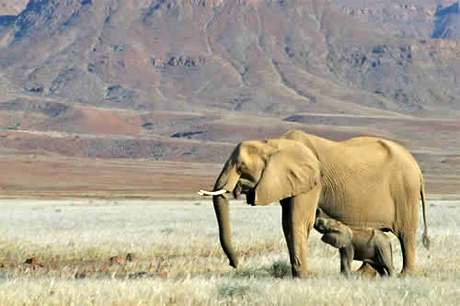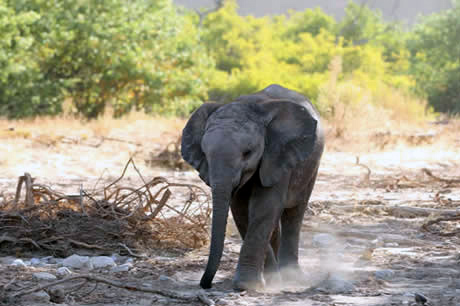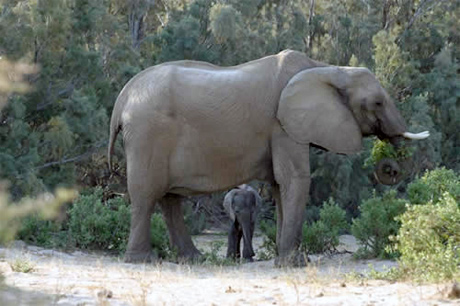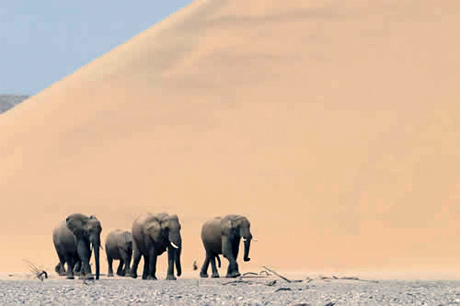Elephant Nomads of the Namib Desert
For BBC Natural World :: Series Editor Tim Martin
Narrated by Russ Boulter

A film for BBC2 documenting for the first time the intimate lives of a unique family of endangered elephants in one of the last true wildernesses today.
Winner - Life on the Edge Award at the Japan Wildlife Film Festival 2009.
Roscar Finalist for 'Best Use of Music' at Durban Wild Talk Africa Film Festival 2009
Programme Summary
This is the remarkable story of two baby elephants struggling to survive their critical first six months in the oldest desert on earth. The Desert Elephants of Namibia suffered a poaching holocaust in the 1980s. As the most endangered elephant population in the world recovers, every single calf is vital. Himba and Dusty are born in a boom year, but when the short-lived rivers on which they depend disappear underground, their lives depend on the memories, experience and decisions of the females who lead their tiny families.
What happened to Himba?

Thank you for writing to me about our film on the elephants of Namibia.
Let me set the scene. We were in a truly remote place. During the entire period of filming we did not know what the outcome would be for Himba. Had we tried to intervene, no help was available. Our location was hundreds of miles from any towns or villages in Northern Namibia. It took two days to drive there from the airport in Windhoek. Each time we arrived at our location, we did not know what we would find. We followed our three families, on repeated trips, for almost six months. It was only during our second trip that we realized Himba was not doing as well as Dusty and something was different in their family dynamics.
Himba always had a chance of recovery during all the time we were filming. A small elephant’s best chance of survival is undoubtedly to stay with its family. When we finally left, Himba was still with his family. If they made it to the area with fresh rains and food, we assessed Himba could survive - as Dusty did. Mortality is at its highest for the youngest desert elephants, but many do make it through difficult times. Dusty did survive his long trip. We were lucky enough to find him again.
The film is an accurate record of the events we observed, and it is as described in the Radio Times – the story of two baby elephants struggling to survive. On our final trip we searched for Himba for several days. It is a vast area. There are no maps and no roads. As we said in the film, we never saw him again and we never found his family again. Some months later, accompanying tourists on a family holiday, one of our drivers returned to the area. He saw Himba's family, but no sign of Himba.
There is no local vet and no elephant orphanage or similar organization in Namibia capable of looking after any injured or stressed animals. In Kenya, by contrast, occasionally baby elephants are treated professionally or in extreme cases taken to an orphanage in Nairobi. We will show this on a 13-part series on the elephants of Amboseli to be broadcast on Animal Planet next year. Unfortunately, no such facilities exist in the wilds of Namibia.
If anyone would like to learn more about research in Kenya and wants to help elephants, one starting point is http://www.elephanttrust.org/ the web site of the Amboseli Trust for Elephants. The ATE is run by elephant expert Cynthia Moss who has been studying elephants for almost 40 years. Hers is the longest study of wild elephants in the world. They work to understand the lives and ensure the future of 1,500 elephants in the Amboseli ecosystem fed by the waters of Kilimanjaro.
The politics of elephants is immensely complex and we do our best to steer our way through this. We have recently been trying to stop the Namibian government allowing the shooting of desert elephants for trophies. I hope by showing how magnificent and precious these animals are, and how fragile are the places in which they live, we are doing something to preserve them.
Unique Elephants
A little-known and surprising group of desert-dwelling elephants roams the far northwest of the Kunene region of Namibia in South West Africa. Extraordinary in their endurance, the small families make marathon treks between the remote shores of the Skeleton Coast and the high Kabere Mountains of the interior. These animals traverse some of the most dramatic, arid, and austere scenery in the world. The secretive nature of their existence was only revealed recently, when cameraman Martyn Colbeck followed them whilst working on the BBC’s landmark series Planet Earth.
The film takes place in the Northwestern Namib Desert. “Namib” means (“vast”). It’s sixteen hundred kilometres long, fifty thousand kilometres square. These are the harshest conditions in the world for elephants. Twenty-five years ago, out of eighty local desert elephants, poachers killed all but three. Now large-scale poaching has ended. The herd has a chance to recover…
The Story Told in the Film
It’s May, the cold dry season in Namibia. Two young calves are born in the Hoarusib valley: Himba and Dusty. Himba is an orphan. His mother died within days of giving birth. Rosa, his grandmother, is doing something elephants don’t normally do – she is adopting him. She is in her late 50s, but she can give him a little milk at the moment, as she is still suckling a seven-year old daughter. Dusty is being fed by both his mother - Broken Tusk - and an older sister.
This is an exceptional year. After record rains, the harsh desert is in bloom. Other members of the herd, led by Left Fang, climb into the nearby mountains in search of myrrh bushes. In the 40-degree C heat, they spray themselves with water from hidden pouches in their throats. This has rarely been seen and never filmed before.

A few weeks later, the weather takes a dramatic turn for the worse. Searing winds from the Kalahari Desert arrive to shrivel plants and watercourses. The female leaders, Rosa, Broken Tusk and Left Fang face life-or-death decisions. To escape, Left Fang leads her family on a non-stop 5-day marathon to the coast. Rosa and Broken Tusk can’t leave till Himba and Dusty are strong enough.
When they make their break, Dusty faces the longest journey he has ever undertaken – a day and two nights ordeal without water. Himba, weaker now that Rosa can no longer feed him properly without risking her young daughter, clings to the last waterhole until his inactivity puts all his companions’ lives in danger. Only then do he and Rosa set off.
Finally, Dusty gains safety and a reward – ana pods, a rich food source. At the coast, unencumbered by young, Left Fang’s family relax and recover. Now the females attract a male suitor. In another two years perhaps a new calf will be born.

Producer - Mike Birkhead
Photography - Martyn Colbeck
Writer - Jeremy Evans
Editor - Nigel Buck
Music - David Mitcham
Sound - Graham Wild and Paul Clark
If you need help filming in Namibia I used Namibfilms - they were great and made our production possible in difficult times when budgets have to go further. Without a doubt I enjoyed my stays in Namibia more than any other location thanks to Guy Nockels and his team which included some great support people like Richard Berkeley, Axel, Tim and Gerry. They just know what a production needs and never let us down - thanks guys. We'll be back!
Our Programmes